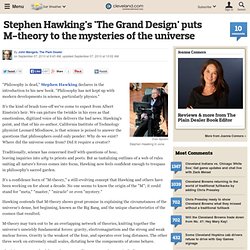

Galaxy. Chromoscope - View the Universe in different wavelengths. How to use Physics to Guess the Number of M&M's in a Jar : Living the Scientific Life (Scientist, Interrupted) Universe to multiverse. Stephen Hawking's 'The Grand Design' puts M-theory to the mysteries of the universe. "Philosophy is dead," Stephen Hawking declares in the introduction to his new book.

"Philosophy has not kept up with modern developments in science, particularly physics. " It's the kind of brash toss-off we've come to expect from Albert Einstein's heir. We can picture the twinkle in his eyes as that emotionless, digitized voice of his delivers the bad news. Hawking's point, and that of his co-author, California Institute of Technology physicist Leonard Mlodinow, is that science is poised to answer the questions that philosophers could only ponder: Why do we exist?
Where did the universe come from? Traditionally, science has concerned itself with questions of how, leaving inquiries into why to priests and poets. It's a confidence born of "M-theory," a still-evolving concept that Hawking and others have been working on for about a decade. Quantum theory eventually helped unite electromagnetism and the strong and weak nuclear forces, but gravity stubbornly stayed outside the tent. Watch the Program (full-screen)
The Elegant Universe: Part 3 PBS Airdate: November 4, 2003 NARRATOR: Now, on NOVA, take a thrill ride into a world stranger than science fiction, where you play the game by breaking some rules, where a new view of the universe pushes you beyond the limits of your wildest imagination.

This is the world of "string theory," a way of describing every force and all matter from an atom to earth, to the end of the galaxies—from the birth of time to its final tick, in a single theory, a "Theory of Everything. " Our guide to this brave new world is Brian Greene, the bestselling author and physicist. BRIAN GREENE (Columbia University): And no matter how many times I come here, I never seem to get used to it. NARRATOR: Can he help us solve the greatest puzzle of modern physics—that our understanding of the universe is based on two sets of laws that don't agree? Orrery_2011_bce.swf (application/x-shockwave-flash Object) My Solar System 2.02. Cqo4t.jpg (JPEG Image, 3850 × 1925 pixels) The Astronomical Highlights of 2010.
Examination of the Fabric of the Universe Video. What a year on Earth really looks like. Dr. Quantom. Physics I: Classical Mechanics - Download free content from MIT. Electricity & Magnetism - Download free content from MIT. University lectures physics. Whether your goal is to earn a promotion, graduate at the top of your class, or just accelerate your life.

Lectures can help get you there. Our archives of lectures cover a huge range of topics and have all been handpicked and carefully designed by experienced instructors throughout the world who are dedicated to helping you take the next step toward meeting your career goals. With OnlineCourses.com's engaging collection of lectures, your free time will turn into self-improvement time.
Our online lectures are more than lecture notes or a slideshow on a topic; they were designed for audiences like you, with carefully sequenced themes and topics taught by veteran educators, and often with additional resources for your own independent study. The lectures are available to anybody, completely free of charge.
Lecture courses are a valid and vital learning tool, and may be one of the best methods of learning available. 2011-15-d-print.jpg (JPEG Image, 3000x2400 pixels) - Scaled (37. Physics III: Vibrations & Waves - Download free content from MIT. The Official String Theory Web Site. Astronomy 161 - Introduction to Solar System Astronomy by Richard Pogge. Physics 20b: Introduction to Cosmology - Spring 2010 - Download free content from UC Irvine.
The-Observable-Universe.jpg (JPEG Image, 3850x1925 pixels) A Geometric Theory of Everything. Modern physics began with a sweeping unification: in 1687 Isaac Newton showed that the existing jumble of disparate theories describing everything from planetary motion to tides to pendulums were all aspects of a universal law of gravitation.

Unification has played a central role in physics ever since. In the middle of the 19th century James Clerk Maxwell found that electricity and magnetism were two facets of electromagnetism. One hundred years later electromagnetism was unified with the weak nuclear force governing radioactivity, in what physicists call the electroweak theory.
This quest for unification is driven by practical, philosophical and aesthetic considerations. When successful, merging theories clarifies our understanding of the universe and leads us to discover things we might otherwise never have suspected. Select an option below: Customer Sign In *You must have purchased this issue or have a qualifying subscription to access this content. NASA's SDO Captures a Monster Prominence [video] Time Dialation.